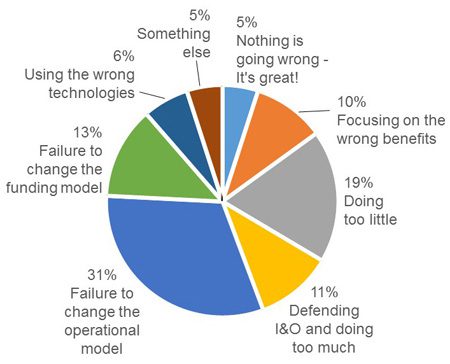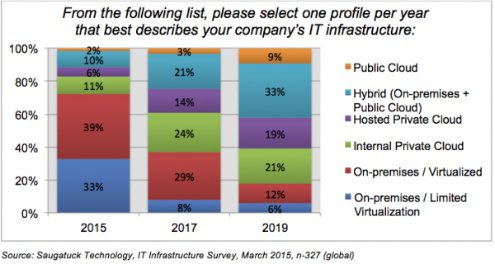There’s no lack of naysayers about the private cloud. I’ve heard many tech pundits – actual cloud experts – say that private cloud is a waste. To build out a private cloud is merely replicating the expense and headache of an in-house datacenter.
Cloud Storage and Backup Benefits
Protecting your company’s data is critical. Cloud storage with automated backup is scalable, flexible and provides peace of mind. Cobalt Iron’s enterprise-grade backup and recovery solution is known for its hands-free automation and reliability, at a lower cost. Cloud backup that just works.
SCHEDULE FREE CONSULT/DEMO
It’s far better, they say, to simply offload to the public cloud. Less fuss, less muss – all around cheaper and more scalable. The magic of cloud is outsourcing your computing needs. You rent on-demand, buying only what you need.
But private cloud? A costly boondoggle that requires too much scarce expertise.
The private cloud naysayers gained big credence from Gartner analyst Thomas Bittman. Last fall, he delivered a solid right jab to the jaw with the blog post: Why Are Private Clouds Failing (which, to be clear, did not say that private clouds are failing, it only listed reasons for possible failure). The reasons he listed – a full 10 points – included “doing too much” and “doing too little.” Apparently doing just the right amount is devilishly difficult with private cloud.
In February he followed up with a wicked uppercut to the chin, with Why Are 95% of Private Clouds Failing. After huge pushback he softened the blog post’s title, which VMware’s Chuck Hollis suggested was clickbait. (Then again, since VMware is a private cloud vendor it has a vested interest.) Yet even with the new, softer title – “Problems Encountered by 95% of Private Clouds” – the blog post packed a wallop.
The post’s graphic is based on 140 responses of businesses with private clouds. Again you’ll notice that both “doing too much” and “doing too little” are problems:

Source: Gartner
Perhaps most damning is that measly 5% who chirped “Nothing is going wrong – it’s great!” Wow. So only a mere sliver of deployments creates happy campers? The private cloud is obviously an albatross.
And inarguably it’s true: the great generational shift in IT is away from the in-house datacenter. The term “legacy” has become a dirty word. In contrast, the ease of public cloud has driven a major tech trend, shadow IT. Have credit card, will compute.
Nicholas Carr’s Big Switch explained to us way back in 2008 that computing would be a public utility – all done by external providers. Computing power is just like electricity, see? Cloud monolith Amazon Web Services agrees with Carr wholeheartedly: public cloud is good, private cloud is bad. (Okay, so Amazon built a private cloud for the CIA. Yet for that one exception – which AWS contracted at $600 million – private cloud is a very, very poor idea.)
Add it all up and it’s clear: if you invest in the private cloud, you’ve somehow missed the biggest advance in computing in our lifetime.
On the Other Hand
Clearly, growth in private cloud is dwarfed by the massive uptake in public cloud adoption – but private cloud is growing quickly. Research firm Technology Business Research forecasts 35% growth in the private cloud sector in 2015. Similarly, Research and Markets forecasts a 22% CAGR in the private cloud between 2013 and 2018.
But private cloud isn’t for everyone, notes Bernard Golden, VP of Strategy for ActiveState and author of Amazon Web Services for Dummies. “The industry perception of private cloud is transitioning from an assumed superior offering compared to public alternatives to one option among many,” he says. “The role for private cloud going forward is for applications that require on-premise location due to data gravity, legal or regulatory restrictions, or cost advantages due to use by a very large organization.”
That is, given the logistics and expense, private cloud is a solution for mid-sized and larger businesses. The local hair salon, for instance, has no need for a private cloud (though they will likely use public cloud for data storage and various apps). At this point, economies of scale are required to harvest return from a private cloud.
Joe Weinman, author of Cloudonomics: The Business Value of Cloud Computing, says “Today’s start-ups obviously have great reasons for slowing burn rate via the public cloud and have the skills to use IaaS and PaaS as well.” However, “Some well-run larger enterprises can achieve a mix of benefits from their own private cloud or a hybrid solution, especially given the diffusion of technology through open source software and hardware.”
As for the Gartner survey of private cloud users, Weinman notes that the problems it reflects are broad-based. “Many of the issues identified by the survey – such as “failure to change the funding model,” “failure to change the operational model, and “focusing on the wrong benefits” – are not unique to private clouds, but private, public, or hybrid clouds, or organizational initiatives in general.”
Gordon Haff, Cloud Evangelist for Red Hat (a vendor that offers private cloud solutions), notes that Big Switch predicted that “everything would go public because of economies of scale. But that just hasn’t happened and, as time goes on, it’s clear that it’s not going to happen anytime soon.”
One of the key reasons why the move to public cloud hasn’t been total: security concerns, real or imagined.
“If anything, real and perceived issues around data sovereignty and governance have cemented the idea that some data and some computing needs to be kept under an organization’s direct control,” Haff says. “The public cloud market is growing both among the global leaders and the long tail of regional and specialist providers, but it’s growing alongside private clouds as part of a hybrid computing model.”
Furthermore, he adds: “The oft-referenced informal Gartner poll suggested that ‘something’ went wrong with most private cloud projects. But that’s hardly distinguishable from pretty much any IT project. I’d like to hear how the 5% for whom everything went perfectly did it!”
How We’ll Think About It in the Future
Enter, confusion. The discussion about private cloud is muddied by the fact that the definition of private cloud is multifaceted.
There are in-house private clouds, which might be essentially software solutions, or “datacenter in a box” converged solutions combining hardware and software. There are private clouds that are hosted, with various flavors of external management. There are even – at least in theory – mobile backpack “private clouds” you carry everywhere. Marten Mickos demonstrated one in 2013; he was then the CEO of private cloud vendor Eucalyptus.

Marten Mickos shows off a mobile “private cloud.” Very George Jetson.
(Eucalyptus, by the way, was bought by HP, which offers “both managed private and managed virtual private platforms.” So there’s yet another variation on private cloud. In fact, HP says its managed virtual private platform is multi-tenant. Wait, what? A private cloud that is multi-tenant? Is there no limit to the deployments that can be called “private cloud”?)
The variety of private clouds offered by public cloud providers is blooming like mushrooms after a spring rain. As Gartner’s Bittman recently wrote, “isolation options from public cloud providers are growing – more and more are offering semi-private, virtual-private, or fully-private capabilities.”
Amazon – again, the great foe of the in-house private cloud – is happy to sell you a Virtual Private Cloud that resides on its own servers. Conceptually it’s a vague idea. A Virtual Private Cloud is your own dedicated, private space on Amazon’s servers. I get it – no multi-tenant, shared pooling of resources. But isn’t your AWS public cloud deployment fully private and secure? Is your public cloud instance like a hotel hallway with no locks on the door – everybody’s space is just public? Sure, I know, there’s an explanation, but the private-public cloud terminology is pretty wiggy.
In short, there are so many permutations of private cloud – so many definitions – that the term private cloud is becoming all but meaningless. In the old days – like 2010 – many companies thought simply using virtualization meant using private cloud; they might not have had the automation and dynamic provisioning to justify the term private cloud. Now, not only are many of those firms truly leveraging a private cloud, that private cloud is headed toward its natural next evolution: union with the public cloud.
In the future, there will be less talk of “private” and “public” cloud – perhaps none at all. There will just be cloud, and it will (mostly) all be hybrid. Granted, the public/private mix will lean heavily toward public.
Take a look at this chart based on a survey of 327 senior IT executives. You’ll see the hybrid model is forecast to be the most deployed configuration by 2019, from its current low-ranking spot today:

Clearly, the private cloud isn’t going away – nor is it a flawed model. It’s an essential building block in what will be the dominant computing mode, the hybrid cloud. So if you hear someone dismissing it, realize they’ve somehow missed the point.
 James Maguire is Senior Managing Editor at Datamation. Twitter: JamesMaguire
James Maguire is Senior Managing Editor at Datamation. Twitter: JamesMaguire
-
Huawei’s AI Update: Things Are Moving Faster Than We Think
FEATURE | By Rob Enderle,
December 04, 2020
-
Keeping Machine Learning Algorithms Honest in the ‘Ethics-First’ Era
ARTIFICIAL INTELLIGENCE | By Guest Author,
November 18, 2020
-
Key Trends in Chatbots and RPA
FEATURE | By Guest Author,
November 10, 2020
-
Top 10 AIOps Companies
FEATURE | By Samuel Greengard,
November 05, 2020
-
What is Text Analysis?
ARTIFICIAL INTELLIGENCE | By Guest Author,
November 02, 2020
-
How Intel’s Work With Autonomous Cars Could Redefine General Purpose AI
ARTIFICIAL INTELLIGENCE | By Rob Enderle,
October 29, 2020
-
Dell Technologies World: Weaving Together Human And Machine Interaction For AI And Robotics
ARTIFICIAL INTELLIGENCE | By Rob Enderle,
October 23, 2020
-
The Super Moderator, or How IBM Project Debater Could Save Social Media
FEATURE | By Rob Enderle,
October 16, 2020
-
Top 10 Chatbot Platforms
FEATURE | By Cynthia Harvey,
October 07, 2020
-
Finding a Career Path in AI
ARTIFICIAL INTELLIGENCE | By Guest Author,
October 05, 2020
-
CIOs Discuss the Promise of AI and Data Science
FEATURE | By Guest Author,
September 25, 2020
-
Microsoft Is Building An AI Product That Could Predict The Future
FEATURE | By Rob Enderle,
September 25, 2020
-
Top 10 Machine Learning Companies 2020
FEATURE | By Cynthia Harvey,
September 22, 2020
-
NVIDIA and ARM: Massively Changing The AI Landscape
ARTIFICIAL INTELLIGENCE | By Rob Enderle,
September 18, 2020
-
Continuous Intelligence: Expert Discussion [Video and Podcast]
ARTIFICIAL INTELLIGENCE | By James Maguire,
September 14, 2020
-
Artificial Intelligence: Governance and Ethics [Video]
ARTIFICIAL INTELLIGENCE | By James Maguire,
September 13, 2020
-
IBM Watson At The US Open: Showcasing The Power Of A Mature Enterprise-Class AI
FEATURE | By Rob Enderle,
September 11, 2020
-
Artificial Intelligence: Perception vs. Reality
FEATURE | By James Maguire,
September 09, 2020
-
Anticipating The Coming Wave Of AI Enhanced PCs
FEATURE | By Rob Enderle,
September 05, 2020
-
The Critical Nature Of IBM’s NLP (Natural Language Processing) Effort
ARTIFICIAL INTELLIGENCE | By Rob Enderle,
August 14, 2020
SEE ALL
CLOUD ARTICLES





 James Maguire is Senior Managing Editor at Datamation. Twitter:
James Maguire is Senior Managing Editor at Datamation. Twitter: 






